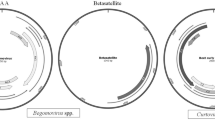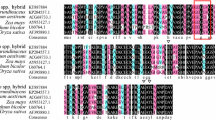Abstract
Intracellular pathogenesis-related gene (IPR) from tomato was cloned from a salicylic acid (SA) induced cDNA library and was designated asTSI-1 (tomato stress induced-1). The deduced amino acid sequence ofTSI-1 codes for a 178 amino acid polypeptide of molecular weight 20.4 kDa.TSI-1 is highly homologous to the potatoSTH-2 andSTH-21 IPR and tree pollen allergens which cause type I allergic reactions in humans.TSI-1 lacks a signal peptide like other IPR members. It is organized as a multigene family and is inducible by SA andFusarium oxysporum infection.
Similar content being viewed by others
References
Breiteneder H, Ferreira F, Sommergrurber K H, Ebner C, Breitenbach M, Rumpold H, Kraft D and Scheiner O 1993 Four recombinant isoforms ofCor a1 three major allergens of hazel pollen, show different IgE binding properties;Eur. J. Biochem. 212 355–362
Bufe A, Spangfort M D, Kahlert H, Schlaak M and Becker W M 1996 The major birch pollen allergen, Bet V 1, shows ribonuclease activity;Planta 199 413–415
Chang C C and Hadwiger L A 1990 Cloning and Characterization of a disease resistance response gene in pea inducible byFusarium solani;Mol. Plant Microbe Interact. 3 78–85
Collinge D P and Slusarenko A J 1987 Plant gene expression in response to pathogens;Plant Mol. Biol. 9 389–410
Constable C P and Brisson N 1992 The defense-related STH-2 gene product of potato shows race-specific accumulation after inoculation with low concentrations ofPhytophthora infestans zoospores;Planta 188 289–295
Crowell D, John M E, Russell D and Amasino R M 1992 Characterization of a stress-induced developmentally regulated gene family from soybean;Plant Mol. Biol. 18 459–466
Delaney T P, Uknes S, Vernooji B, Friedrich L, Weymann K, Negrotto D, Gaffney T, Gut-Rella M, Kessmann H, Ward E and Ryals J 1994 A central role of salicylic acid in plant disease resistance;Science 266 1247–1250
Dellaporta S L, Wood J and Hicks J B 1983 A plant DNA minipreparation: version II;Plant Mol. Biol. Rep. 4 19–21
Gaffney T, Friedrich L, Vernooij B, Negrotto D, Nye G, Uknes S, Ward E, Kessmann H and Ryals J 1993 Requirement of salicylic acid for the induction of systemic acquired resistance;Science 261 754–756
Hammond-Kosack K E, Oliver R, Harrison K, Ashfield T and Jones J 1992 Studies on the mechanism by which tomatocf (Cladosporium fulvum) resistance genes activate plant defense; inAdvances in molecular genetics of plant-microbe interactions (eds) E W Nester and DPS Verma (Dordrecht: Kluwer) vol 2, pp 457–461
Hammond-Kosack and Jones 1996 Resistance gene dependent plant defense responses;Plant Cell. 8 1773–1791
Huang J C, Chang F C and Wang C S 1997 Characterization of a lily tapetal transcript that shares similarity with a class of intracellular pathogenesis-related (IPR) proteins;Plant Mol. Biol. 34 681–686
Iturriaga E A, Leech M J, Barratt D H P and Wang T L 1994 Two ABA-responsive proteins from pea (Pisum sativum L) are closely related to intracellular pathogenesis-related proteins;Plant Mol. Biol. 24 235–240
Kauss H, Jeblick W, Zielger J and Kraber W 1994 Pretreatment of parsley (Petrselinium crispum L) suspension cultures with methyljasmonate enhanced the elicitation of active oxygen species;Plant Physiol. 105 89–94
Larsen J N, Stroman P and Ipsen H 1992 PCR based cloning and sequencing of isogenes encoding the tree pollen major allergenCarb1 fromCarpinus betulus, hornbean;Mol. Immunol. 29 703–711
Marineau C, Matton D P and Brisson N 1987 Differential accumulation of potato tuber mRNAs during the hypersensitive response induced by arachidonic acid elicitor;Plant Mol. Biol. 9 335–342
Matton D P and Brisson N 1989 Cloning, expression and sequence conservation of pathogenesis related gene transcripts of potato;Mol. Plant-Microbe Interact. 2 325–331
Matton D P, Bell B and Brisson N 1990 Nucleotide sequence of a pathogenesis-related gene of potato;Plant Mol. Biol. 14 863–865
Matton D P, Prescott G, Bertrandd C, Camirand A and Brisson N 1993 Identification of cis-acting elements involved in the regulation of the Pathogenesis-related gene STH-2 in potato;Plant Mol. Biol. 22 279–291
Midoh N and Iwata M 1996 Cloning and characterization of a probenaole-inducible gene for an intracelluar pathogenesis-related protein in rice;Plant Cell Physiol. 37 9–18
Moiseyev G P, Beintema J J, Fedoreyeva L I and Yakovlev G I 1994 High sequence similarity between a ribonuclease from ginsgeng calluses and fungus-elicited proteins from parsley indicates that intracellular pathogenesis-related proteins are ribonucleases;Planta 193 470–472
Mur L A J, Naylor G, Warner S A J, Sugars J M, White R F and Draper J 1996 Salicylic acid potentiates defense gene expression in tissue exhibiting acquired resistance to pathogen attack;Plant J. 9 559–571
Mylona P, Moerman M, Yang W C, Gloudemans T, Kerckhove J V D, Kammen A, Ton Bisseling T and Franssen H J 1994 The root epidermis-specific pea gene is a homologous to a pathogenesis-related gene;Plant Mol. Biol. 26 39–50
Ponstein A S, Bres-vloesmans S A, Sela-Buurrlage M B, Van de Elzen P J M, Melchers L S and Cornelissen B J C 1994 A novel pathogen and wound-inducible tobacco (Nicotinana tabacum) protein with antifungal activity;Plant Physiol. 104 109–118
Ryals J A, Neuenschwander U H, Willits G M, Molina A, Steiner H and Hunt M D 1996 Systemic acquired resistance;Plant Cell 8 1809
Somssich I E,. Schmelzer E, Kawalleck P and Hahlbrock K 1988 Gene structure and in situ transcript localization of pathogenesis related protein 1 in parsley;Mol. Gen. Genet. 213 93–98
Swoboda I, Jilek A, Ferreira F, Engel E, Sommergruber K H, Scheiner O, Kraft D, Brieteneder H, Pittenauer E, Schmid E, Vicente V, Heberle-Bors E, Ahorn H and Breitenbach M 1995 Isoforms ofBetV1 the major birch pollen allergens analyzed by liquid chromatography, mass spectrometry and cDNA cloning;J. Biol. Chem. 270 2607–2613
Truesdell G M and Dickman M B 1997 Isolation of pathogen/stress-inducible cDNAs from alfalfa by mRNA differential display;Plant Mol. Biol. 33 737–743
Van Kan J A L, Cozijnsen T, Danhash N and de Wit P J G M 1995 Induction of tomato stress protein mRNA by ethephon, 2,6-dichoroisonicotinic acid and salicylate;Plant Mol. Biol. 27 1205–1213
Walter M H, Liu J W, Grand C, Lamb C J and Hess D 1990 Bean pathogenesis-related (PR) proteins deduced from elicitorinduced transcripts are members of a ubiquitous new class of conserved PR proteins including pollen allergens;Mol. Gen. Genet. 222 353–360
Warner S A J, Scott R and Draper J 1992 Characterization of a wound-induced transcript from the monocot asparagus that shares similarity with a class of intracelluar pathogenesis-related (PR) proteins;Plant Mol. Biol. 19 555–561
Warner S A J, Gill A and Draper J 1994 The developmental expression of the asparagus intracellular PR protein (AoPR1) gene correlates with sites of phenylpropanoid biosynthesis;Plant J. 6 31–34
Xu Y, Chang P F L, Liu D, Narasimhan M L, Raghothama K G, Hasegawa P M and Bressan R.A 1994 Plant defense genes are synergistically induced by ethylene and methyl jsamonate;Plant Cell. 6 1077–1085
Yamamoto M, Torikai S and Oeda K 1997 A major root protein of carrots with high homology to intracelluar pathogenesisrelated (PR) proteins and pollen allergens;Plant Cell Physiol. 9. 1080–1086
Author information
Authors and Affiliations
Corresponding author
Rights and permissions
About this article
Cite this article
Vidya, C.S.S., Manoharan, M. & Sita, G.L. Cloning and characterization of salicylic acid-induced, intracellular pathogenesis-related gene from tomato (Lycopersicon esculentum). J. Biosci. 24, 287–293 (1999). https://doi.org/10.1007/BF02941242
Received:
Accepted:
Published:
Issue Date:
DOI: https://doi.org/10.1007/BF02941242




